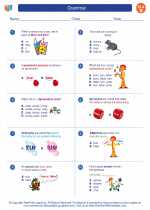What is an Adverb?
An adverb is a word that modifies or describes a verb, an adjective, or another adverb. It provides more information about how, when, where, or to what extent something is done.
Types of Adverbs
Adverbs can be categorized into different types based on the kind of information they provide:
- Manner: Adverbs that describe how an action is done, e.g., quickly, carefully, happily.
- Time: Adverbs that indicate when an action takes place, e.g., yesterday, soon, now.
- Place: Adverbs that show where an action occurs, e.g., here, there, everywhere.
- Degree: Adverbs that specify the extent or degree of an action, e.g., very, quite, too.
- Frequency: Adverbs that indicate how often an action occurs, e.g., always, often, seldom.
Study Guide
Here are some tips for understanding and using adverbs:
- Identify the verb, adjective, or another adverb that the adverb is modifying.
- Determine the type of information the adverb is providing (manner, time, place, degree, frequency).
- Remember that many adverbs are formed by adding -ly to an adjective (e.g., quick → quickly, happy → happily).
- Practice using adverbs in sentences to see how they modify different parts of speech.
Examples
Here are some examples of adverbs in sentences:
- The dog barked loudly (manner).
- We will go to the park tomorrow (time).
- The cat sat there (place).
- She is extremely talented (degree).
- They often visit their grandparents (frequency).
[Adverb] Related Worksheets and Study Guides:
.◂English Language Arts Worksheets and Study Guides Second Grade. Grammar
Study Guide Grammar
Grammar  Worksheet/Answer key
Worksheet/Answer key Grammar
Grammar  Worksheet/Answer key
Worksheet/Answer key Grammar
Grammar  Worksheet/Answer key
Worksheet/Answer key Grammar
Grammar 

 Worksheet/Answer key
Worksheet/Answer key
 Worksheet/Answer key
Worksheet/Answer key
 Worksheet/Answer key
Worksheet/Answer key

The resources above cover the following skills:
Students employ a wide range of strategies as they write and use different writing process elements appropriately to communicate with different audiences for a variety of purposes. (NCTE)